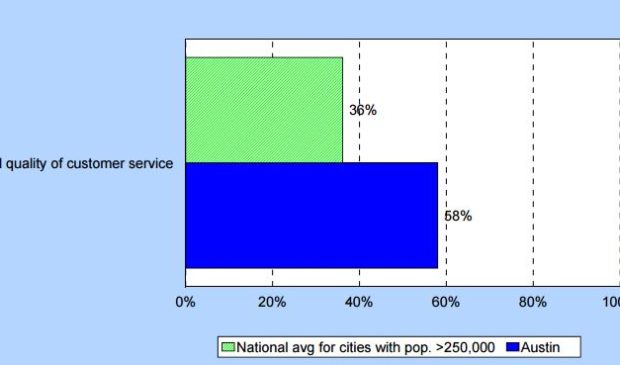Survey says: Austinites dissatisfied with traffic, happy with most else
Thursday, February 16, 2017 by
Kara Nuzback New survey findings show Austin residents are generally happier with city services such as fire, police, library, and parks and recreation than residents of similarly populated cities. But Austin falls behind the national average of satisfaction in an unsurprising category: traffic.
Jason Morado, project manager of the Kansas City, Kansas-based ETC Institute, presented the report to City Council at its work session yesterday. The results were acquired from more than 2,000 surveys administered to randomly selected households, with a minimum of 200 surveys coming from each Council district.
Among the respondents, 86 percent indicated they were dissatisfied with the traffic flow on major highways in the city.
Council Member Leslie Pool noted that the city has no authority over major highways. But in another question, 72 percent of respondents said they were dissatisfied with the traffic flow on major city streets, over which the city has authority.
Austin ranks 20 percent below the national average of satisfaction of traffic flow on major city streets among cities with more than 250,000 residents, according to ETC.
Austin Chief Performance Officer Kimberly Olivares said many of the city’s traffic issues are symptoms of construction and growth, and the city has taken steps to alleviate congestion, including the $720 million transportation bond voters approved in November.
“We know that traffic continues to be a major challenge,” Olivares said.
Morado said most residents surveyed are also dissatisfied with the city’s plan for growth. Survey results show just 13 percent of Austin residents were satisfied with how well the city is planning its growth compared to a national average of 33 percent. Austin’s planning for growth satisfaction rate is also down from 34 percent in 2010, according to ETC.
Morado said that although resident satisfaction with city services overall has declined, Austin continues to show higher-than-average satisfaction rates for parks and recreation, public safety, the quality of drinking water and the quality of city libraries.
Austin ranks significantly higher than comparable cities as a place where residents say they feel safe in their neighborhoods at night, with a 70 percent satisfaction rate compared to a national average of 49 percent.
Eighty percent of residents are satisfied with Austin as a place to live, 76 percent are satisfied with Austin as a place to work and 70 percent are satisfied with their overall quality of life in the city, the findings show.
Austin also beats the national average in terms of residents’ satisfaction with customer service in the city, Morado said. Fifty-eight percent of residents surveyed were satisfied with the overall quality of customer service they received from city representatives, beating a national average of 36 percent satisfaction, according to the results.
According to ETC, comparable cities with populations higher than 250,000 include Dallas, Denver, Fort Worth, Las Vegas, Plano, San Antonio, San Francisco, Seattle and Tucson.
Olivares said the city outranks the national benchmark of customer service largely due to its Service With PRIDE initiative, launched in 2015, which trains city employees to understand the customer’s journey from start to finish and identify breaks in customer service delivery. Twenty city departments have completed the training, eight departments are undergoing training and seven departments are scheduling PRIDE training, Olivares said.
Pool said that overall, she was heartened by the mostly positive results of the survey.
“We recognize that there’s always room for improvement,” she said.
Mayor Steve Adler said the survey was skewed toward homeowners and that he was interested to know how the results would change if more renters had participated. Renters make up the majority of residents in Austin, he said.
According to ETC, 26 percent of respondents were renters and 74 percent were homeowners.
Morado said homeowners are more invested in the city and more likely to reside in Austin for longer.
Council Member Jimmy Flannigan said it was unfair to assume renters were not invested in the city.
“I’m a renter, and I’m a City Council member, and I’m not going anywhere,” he said.
Flannigan said it would dramatically change the results to include more renters, who, for example, do not often have easy access to city parks. He said the survey underrepresented the majority of the Austin community.
Download (PDF, 2.01MB)
The Austin Monitor’s work is made possible by donations from the community. Though our reporting covers donors from time to time, we are careful to keep business and editorial efforts separate while maintaining transparency. A complete list of donors is available here, and our code of ethics is explained here.
You're a community leader
And we’re honored you look to us for serious, in-depth news. You know a strong community needs local and dedicated watchdog reporting. We’re here for you and that won’t change. Now will you take the powerful next step and support our nonprofit news organization?









